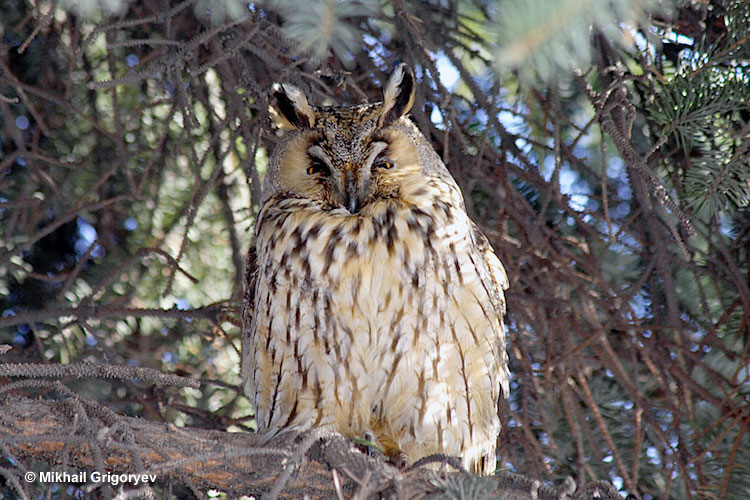The Long-eared Owl (Asio otus) is a medium-sized, slender owl species with long ear tufts, and a reddish-brown face.
If you notice a medium-sized owl roosting in a conifer, you may have found this bird. Carefully checking for well-hidden Long-eared Owls in dense conifer stands during the winter sometimes reveals several roosting individuals.
On this page
Identification
Male
The male Long-eared Owl is a slender, medium-sized owl a bit smaller than a crow. On average, it is 14 inches long, has a wingspan of two feet and ten inches, and weighs 9.2 ounces.
This owl has long, dark ear tufts, yellow-orange eyes, and a pumpkin-orange face. The male owl also has white and black markings between its eyes, a black beak, and thick, dark markings on its chest.
On its pale underparts, the Long-eared Owl has blackish streaks with short bars.
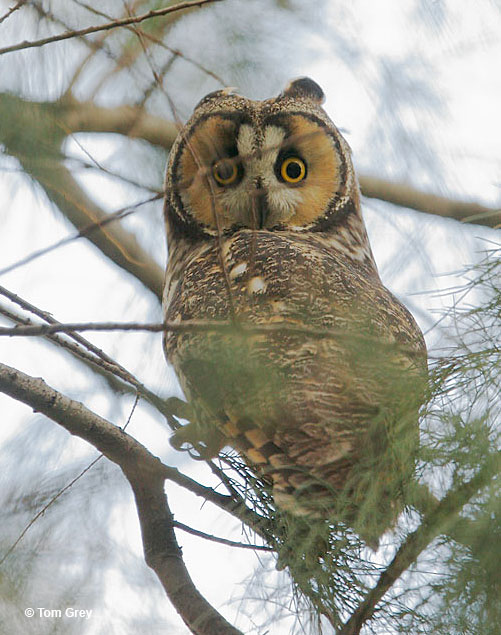
Male and female Long-eared Owls look identical apart from size.
Female
The female Long-eared Owl looks a lot like her male counterpart but is larger. However, unlike many other owl species, she is only a little bit bigger than the male.
She is 15 inches long, has a wingspan of three feet, and weighs 11 ounces. Like the male, she has orange coloration on her face and yellow-orange eyes. The female Long-eared Owl also has the same underparts pattern as the male but she is darker below and has more red-brown highlights.
This owl species is also mottled gray-brown above, and has a pale buff vent.
Vocalizations
The song of the male Long-eared Owl is a loud, hoo repeated several times, every three seconds. The female Long-eared Owl makes quiet, nasal sounds.
Food
The Long-eared Owl feeds on a variety of small mammals. It also catches small birds, and, in some places, they can make up a large part of its diet.
This owl species mostly eats voles, mice, pocket gophers, shrews, young rabbits, and other small rodents. Occasionally, in arid environments, it can catch small lizards and even small snakes.
Long-eared Owls mostly hunt by flapping and gliding low over the ground. When they detect prey, they drop down to catch it with their long, sharp talons. They swallow small prey whole but pick apart other prey items, especially small birds.
During windy or rainy weather, Long-eared Owls also hunt by waiting on a perch and flying out to catch prey on the ground.
They often hunt in meadows and other, similar open habitats next to patches of forest, dense tree stands, and gallery woodlands.
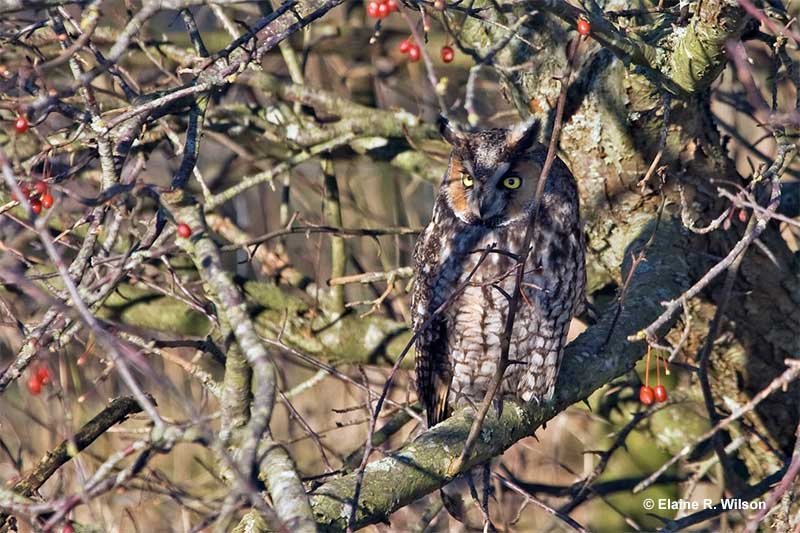
This species can also hunt in open forests but does not catch prey inside dense forests or places with a thick understory. It has excellent hearing and can catch mice in total darkness!
Long-eared Owls are also capable of catching roosting birds in grass and taking them from branches when needed. They usually hunt at night but, on occasion, this owl species also forages in the late afternoon.
Nesting and Eggs
The Long-eared Owl usually nests from mid-March to mid-May. To find a nest, the male performs courtship flights over appropriate habitat and the female picks a spot.
Instead of building a nest, the female owl uses an old squirrel nest, or other fair-sized nest made of sticks. Some of the more common bird nests used by this species include old magpie nests, crow nests, and hawk nests.
They can also use nests built on cliff ledges, the top of a large, broken off cactus stems, or even large, artificial basket nests. This owl prefers nesting sites in clumps or stands of trees near open areas.
The female Long-eared Owl lays five white eggs and incubates them for 26 to 28 days. The eggs are 1.5 inches long and weigh .86 ounces.
During incubation, the male owl feeds the female and, after hatching, continues to feed her and the nestlings for the first two weeks.
By the third week, although they are still flightless, the young birds leave the nest and perch on nearby branches.
At first, they spread out, but when they can fly, the fledgling owls roost near each other. Their father feeds them until they are ten to eleven weeks old.
Current Situation
The Long-eared Owl breeds in forest, riparian zones, and clumps of trees near meadows and open fields. It nests in a large part of Canada, much of the northern and western USA, Europe, northern Asia, and parts of North Africa.
In winter, we find it in similar habitats in much of its breeding range along with southern Canada, much of the USA, and Mexico.

The Long-eared Owl is listed as Least Concern in the IUCN Red List, as Endangered in Illinois, Threatened in Iowa, and a species of special concern in several other states.
Although good numbers of Long-eared Owls are believed to occur in its large range, it has become locally threatened in some places. Declines in this species have been caused by rodent poison, and habitat loss.
Long-eared Owls need riparian zones or stands of trees near natural meadows and grasslands required for hunting. Any changes to such habitats can quickly eliminate the birds from those areas.
Facts
- This is a fairly long-lived bird. Some adult Long-eared Owls in the wild can live for thirty years.
- Putting up artificial baskets and nest boxes with an open front can help Long-eared Owls. They readily use such situations for nesting. These are especially helpful in places where crow populations have declined and resulted in few old crow nests being available for the owls to use as their own nests.
- The male Long-eared Owl has a far carrying hoot. On a clear night, his hooting song can be heard for .7 miles!
- On account of its long ear tufts, this bird is also known as the Northern Long-eared Owl, the Cat Owl, and the Lesser Horned Owl.
- In winter, large numbers of Long-eared Owls can roost in one spot. In conifer stands next to open areas, a dozen or more Long-eared Owls can occur. In southern Ontario, thirty, or even forty Long-eared Owls have been found roosting and hiding close to each other in parks planted with pines. However, the town of Kikinda, Serbia has the record. Incredibly, each winter, up to 600 Long-eared Owls roost in the town square!
Similar Species
The Long-eared Owl is fairly distinctive but it does resemble some other owl species. If we can see its red-orange face, long ear tufts, and slender body, we know we have a Long-eared Owl.
Great Horned Owl
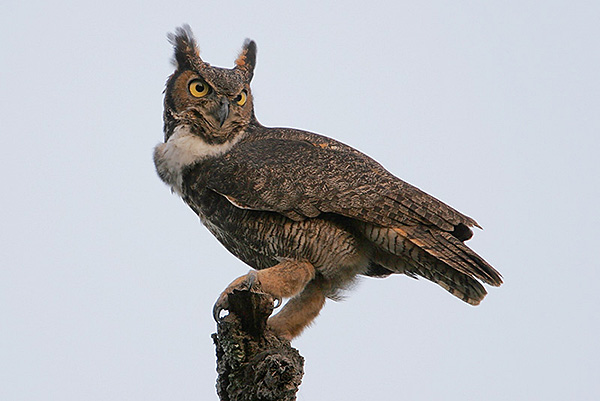
Photographs © Greg Lavaty.
The Great Horned Owl has a similar appearance, especially on its head. However, it is much bulkier, has fine barring below instead of dark streaks, and usually has a white patch on its throat or upper chest. It also has smaller ear tufts.
Eastern Screech-Owl
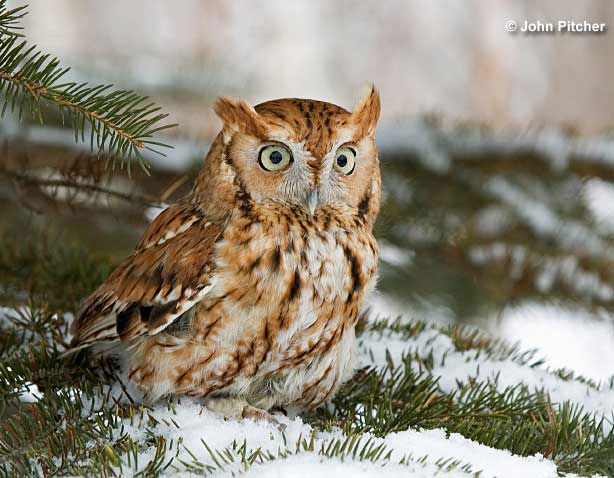
Eastern Screech-Owls are much smaller than Long-eared Owls. They also lack the contrasting pumpkin-orange colors on their face, have smaller ear tufts, and don’t have the blackish chest of the Long-eared Owl.
Short-eared Owl
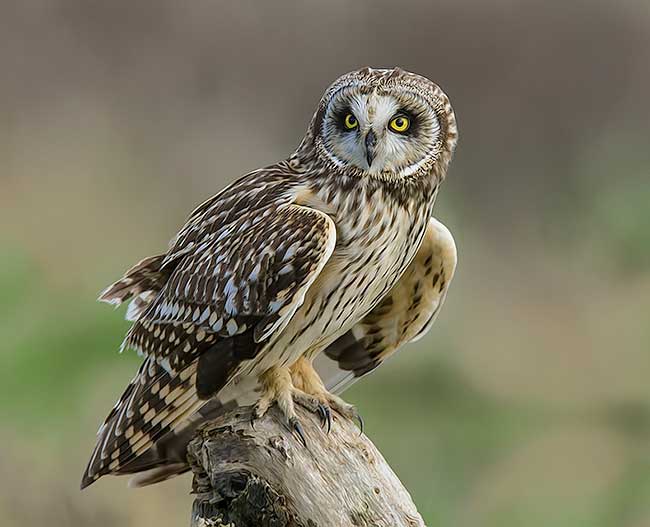
Photos © Alan Wilson
Short-eared Owls are similar in size to Long-eared Owls and also have similar, long wings. They can also hunt in the same open fields, but the Short-eared Owl is usually paler, has buffier wings, and finer streaks on its underparts. It also has very short ear tufts.
Frequently Asked Questions
Where do Long-eared Owls live?
Long-eared Owls live in areas with patches of dense forest and big trees near meadows and other open habitats.
How rare is a Long-eared Owl?
A Long-eared Owl is not rare but they aren’t very common either. Since they are nocturnal and hide very well during the day, they can be hard to find.
What is the difference between a Long-eared Owl and a Great Horned Owl?
The difference between a Long-eared Owl and a Great Horned Owl is that the Long-eared Owl is smaller, slenderer, and has dark streaks on its underparts. The Great horned Owl has finely barred underparts, and also has shorter ear tufts.
What is the lifespan of a Long-eared Owl?
The lifespan of a Long-eared Owl can be ten years or more, although one bird in Europe was known to live for 30 years.
What does a Long-eared Owl symbolize?
A Long-eared Owl symbolizes clear intentions in the passionate and steadfast pursuit of your goals.

